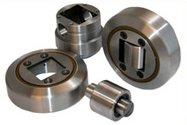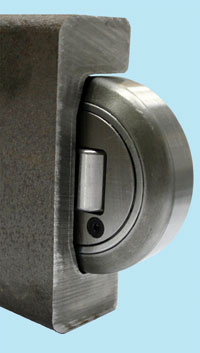HOME > COMBINED ROLLER BEARINGS > GETTING MORE FROM COMBINED ROLLER BEARINGS
GETTING MORE FROM COMBINED ROLLER BEARINGS
The following article was published in Industrial Technology Magazine. The original article can be read here.
What is a combined roller bearing, and what sorts of problems does it solve?
We asked the experts at Euro-Bearings for the answers, and for advice on the many uses to which combined roller bearings and mating steel profiles can be put.
We asked the experts at Euro-Bearings for the answers, and for advice on the many uses to which combined roller bearings and mating steel profiles can be put.
The combined roller bearing is an inherently simple product, and yet it is a fundamental mechanical solution that solves a number of problems in demanding applications. When a little imagination is applied to combined roller bearings and their mating profiles, then high performance linear guidance systems can be quickly developed to meet the needs of many diverse industries and environments.
So just what is a combined roller bearing? It comprises a cylindrical roller bearing - a 'maximum capacity' type (ie full of steel rollers and without a cage to separate them) - as part of a non-separable design which rotates on a weldable steel hub, known as the radial roller. Inside the hub and set at 90º to the radial roller is another bearing - a needle roller, again of 'max capacity' type. This is the axial roller. Both bearings are sealed with a hybrid rubber/metal seals.
These products can solve many heavy duty linear guidance problems in a diverse range of industries and environments, carrying loads from tens of kilos up to hundreds of tonnes.
Simple mounting
To use the combined roller bearing, a hole the same size as the spigot on the rear of the hub is drilled or milled in a steel member. The hub is then welded into place, filling the 45º weld fillet around the circumference of the spigot with weld. An optional mounting plate is available that allows the user to pre-weld the bearing to the plate and then attach the plate using bolt and nut through clearance holes or machine screws into the threaded holes in the plate. In use the combined roller bearing engages in a C or H section profiled steel section. The radial roller engages on the flanges of the profiled section and the axial roller engages on the web of the profiled section. These sections are much thicker and heavier in section than 'standard' beams or columns. The profile is formed to exactly match the bearing outer profile.
This system has a number of performance advantages. It can be used both vertically and horizonally, and will accept cantilevered loads and telescopes. Further, the design means that operation in even the harshest of environments is not a problem. Most importantly, when designing a heavy duty sliding system it is very unlikely that the radial bearing will crab or lock in its steel section because any twisting action is immediately counteracted by the axial bearing running into and along the web. Because bearings are cylindrical and needle roller types they immediately want to rotate under dynamic load.
Heavy duty applications
Crabbing has traditionally been an issue in heavy duty applications across a range of industries, and engineers have struggled with means to combat the problem. For example, fork truck manufacturers have been aware for many years that there was a tendency within the mast for the bearings they were using to crab. This meant that the mast bearing would actually skid or crab or even, in the worst cases, lock in the mast channel. To get around this, many fork truck manufacturers used a second 'side load roller' bearing to prevent that from happening. The combined roller bearing simply brings this solution into one unit by combining the main load carrier (radial bearing) with the anti-twist bearing (axial bearing).
This provides an inherently simpler solution which, combined with the simple mounting, effectively 'engineers out' many operations required in mounting a bearing as a track roller.
Although there is very little truck manufacturing still carried out in the UK, there are numerous areas of industry where these combined roller bearings and steel profiles are being used and providing performance advantages. Many find their way into specialised handling equipment, with one example being the special lift mechanism created to lift the 50 tonne wing of the A380. Massive Jumbo bearings and special welded and profiled rails were used to achieve this. At the other end of the spectrum, a production engineer can use four small combined bearings and two of the smallest steel profiles to create a low cost slide to move a workpiece from one machine to the next.
Wide ranging applications
The range of applications where these products are found is almost limitless. They have successfully solved engineering problems in oil drilling and exploration equipment, and in marine cable and pipe laying equipment. They also provide good solutions in the likes of palletisers, goods lifts, vehicle lifts, test rigs, manufactured concrete and aggregate conveyors and other materials handling equipment tasks. They have been used in a variety of theatre and film applications, for example for lighting gantries.
Their precision has made them attractive for medical equipment, while their ability to operate reliably in demanding environments has made them a good choice for furnace chargers/dischargers and for brick making. In vehicle applications, combined roller bearings answer the needs of agricultural equipment, trailers, specialised vehicles, fork truck attachments and fleet support. In short, this really is one of those products where the designer's imagination is the only limit to its use.
Euro-Bearings has a small but very experienced team who can assist in developing ideas that use this versatile products. And they love a challenge.
| Standard Combined Bearings |  |
| Channel / Profile Data | |




